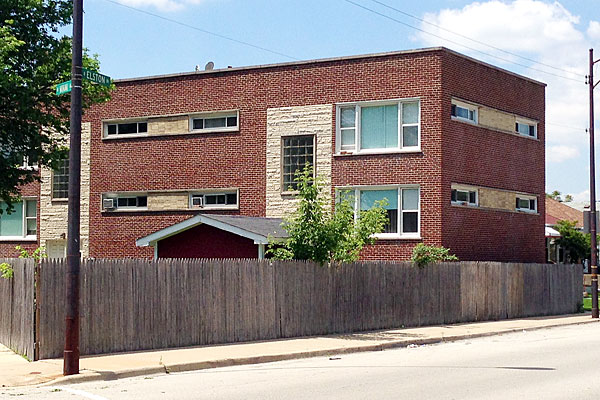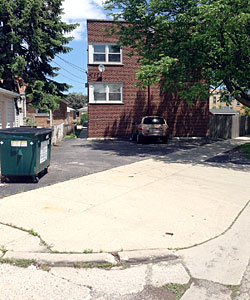
Photos: Dennis Rodkin
Now on the market: a five-unit apartment building where neighbors and investigators have long suspected that the bodies of uncounted and unidentified victims of serial killer John Wayne Gacy may be buried in the yard and under the driveway.
The listing for the five-flat apartment building in Norwood Park says it has three two-bedroom and two one-bedroom apartments, is well-maintained and has room on the extra-large lot for a new garage. Rents on the units “could be higher,” the listing says. The asking price is $599,000.
Listing agent Michael Michalak told me that putting the building on the market had nothing to do with a recent flurry of publicity about its purported status as a possible graveyard for more Gacy victims. “This is the first I’m hearing of any of this,” Michalak said. “I didn’t know there was any controversy.” He declined to connect me with the building’s owner. According to public records, the building has been owned by the same family since at least 1987. The present owner lives in Lake Forest and has an unlisted phone number.

The driveway behind the building where people suspect more of Gacy’s victims may be buried.
The modest apartment building is four miles east of the former site of Gacy’s own Norwood Park house, which was ripped apart in the 1978–79 investigation of his gruesome killings of at least 33 boys and young men. At the time, neighbors around this small apartment building—where Gacy had been the maintenance man and where his mother, Marion, lived in the basement flat—reportedly suspected that Gacy had buried more bodies on the lot.
But Bill Dorsch, a police officer and acquaintance of Gacy who lived near the apartment building, says that when in 1998 he told investigators about the details—neighbors saying they had seen Gacy digging unexplained trenches in the yard and that they later found those trenches suddenly filled in—nobody followed up. One neighbor even claims that when he reported suspicions to the police, he was told, “Bruno, we don’t want any more bodies.”
In 1998, Chicago police investigated the site with radar and a dig, but said there was no sign of human remains.
The site has attracted attention again in the past year or so, as Dorsch’s ongoing investigation sparked the interest of documentary film producer Tracy Ullman and Alison True, who for 16 years was the editor of the Chicago Reader. Dorsch and Ullman are investigating and True is blogging about their and others’ research at the John Wayne Gacy’s Other Victims site.
(Disclosure: I’ve had professional relationships with both True and Ullman in the past. I wrote for True regularly at the Reader, and I attended meetings with Ullman about TV projects—but in both cases, the subject matter had nothing to do with Gacy.)
Their work sparked new interest in the site, and in March, Cook County Sheriff Tom Dart conducted another investigation there using ground-penetrating radar, which he said found no new evidence of Gacy victims. But this month, an article in The Verge quoted a radar expert who had been part of the 1998 investigation saying after the 2013 investigation that radar is insufficient. “If you really want to know what’s underground, Ron LaBarca of US Radar told Verge, “you gotta dig.”
Now it turns out that during the month that Dart’s team was investigating on the property, it went up for sale. Michalak would not say anything else about the property. As True points out, Michalak’s listing expressly asks potential buyers, “Please do not talk to tenants.”




Comments are closed.